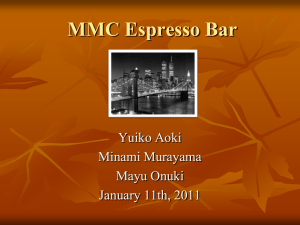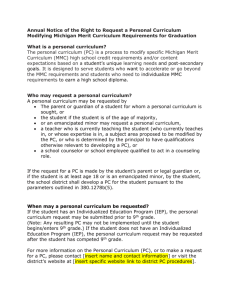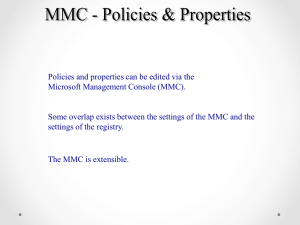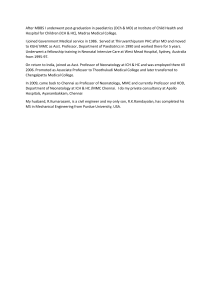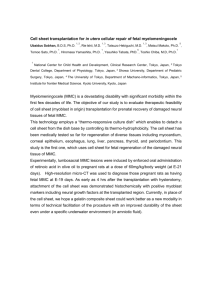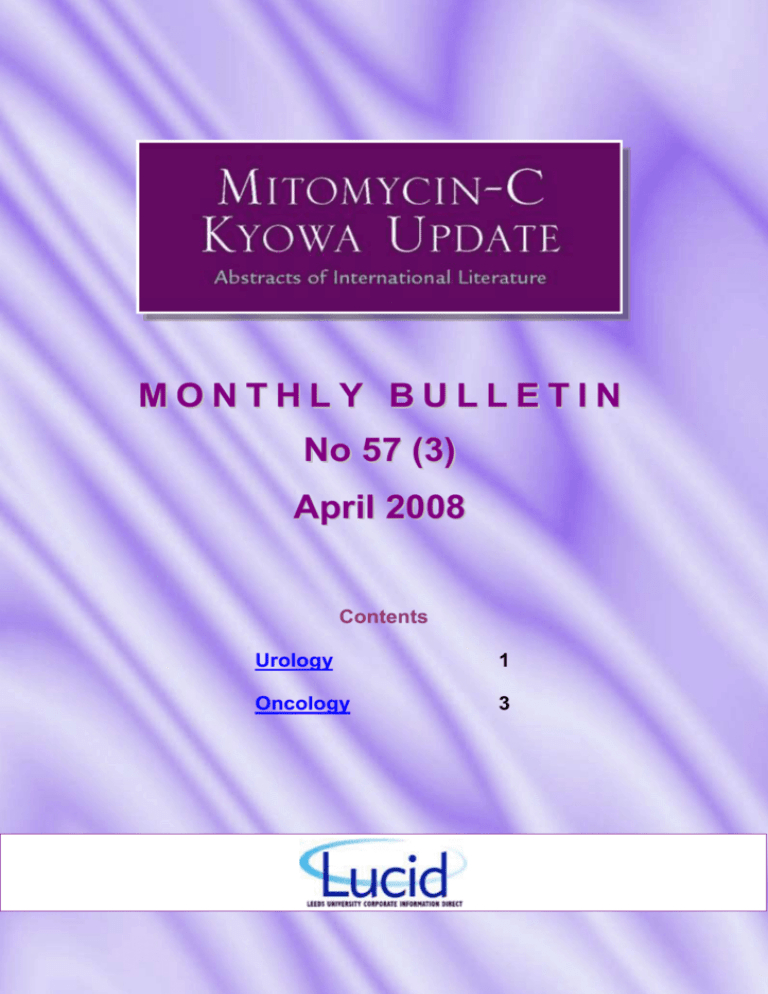
MONTHLY BULLETIN
No 57 (3)
April 2008
Contents
Urology
1
Oncology
3
Urology
Influence of Ta superficial transitional cell carcinoma size on the efficacy of
mitomycin-C treatment. [Meeting Abstract]
HAN C, WILLIAMS E, LENAGHAN D, OPESKIN K, GOAD J
BJU Int 2008;101(Suppl 1): 38-9
INTRODUCTION: Floating tumour debris is often present after TURBT. Previous studies
show these can contain cancer cells. MMC is now routinely given to prevent tumour
implantation. We hypothesise that above a critical size, MMC is ineffective because of
greater distances needed to penetrate the tumour mass. METHODS: Superficial bladder
tumours from ten patients were collected endoscopically using cup biopsy forceps without
diathermy. All patients had Ta low-grade transitional cell cancers. The tumour was bisected;
the control half was suspended in culture medium (DMEM and FBS) in a 37° incubator for 25
hours. The treatment half was suspended in MMC at the concentration of 0.5 mg/ml for one
hour. After washout, this was incubated in culture medium. Tissue was analysed using
histology and caspase-7 immunohistochemistry for apoptosis. RESULTS & DISCUSSION:
Tumour diameter ranged from 1-8 mm. The control group demonstrated minimal apoptosis.
The treatment group demonstrated widespread apoptosis both in the epithelium and in the
fibrovascular core. There was no evidence of an apoptosis gradient with different tumour
sizes. The studied tumours were papillary histologically, consisting of a branching
fibrovascular core covered consistently with dysplastic epithelium 8-10 cell layers thick
regardless of tumour size. This may explain why MMC can equally penetrate and induce
apoptosis even in larger tumour masses. CONCLUSION: In Ta low-grade bladder tumours,
tumour fragments size (up to 8 mm) doesn’t affect MMC efficacy. This may be due to their
papillary, branching structure. A similar investigation should be performed on high-grade,
more solid bladder TCCs in the future.
Carcinoma in situ of the bladder: long-term results of a randomised prospective study
comparing intravesical electromotive mitomycin-C, passive diffusion mitomycin-C
and bacillus Calmette-Guérin. [Meeting Abstract]
DI STASI SM, STORTI L, GIURIOLI A, ZAMPA G, LIBERATI E, SCIARRA M, et al.
Eur Urol Suppl 2008;7(3): 180
INTRODUCTION & OBJECTIVES: We report the long-term follow-up analysis of a
randomized prospective study assessing the efficacy of intravesical passive diffusion MMC
(PD/MMC), electromotive/MMC (EMDA/MMC) and bacillus Calmette-Guérin (BCG) in
patients with carcinoma in situ (Tis) of the bladder. MATERIAL & METHODS: Between 1994
and 2001, 108 patients with histologically proven multi-focal Tis of the bladder were
randomly assigned to (i) 40 mg EMDA/MMC instillation with 20 mA electric current for 30
minutes (n = 36); (ii) 40 mg PD/MMC with a dwell time of 60 minutes (n = 36); or (iii) 81 mg
BCG with a dwell time of 120 minutes (n = 36). All patients were scheduled for six weekly
treatments. Non-responders received another six weekly treatments while responders
received ten monthly follow-up treatments. The primary endpoints were the complete
response rates at three and six months; secondary endpoints were the disease-free interval,
time to progression, overall and disease-specific survival. Analyses were done by intention to
treat. RESULTS: The complete response rates at three months for the PD/MMC,
EMDA/MMC and BCG groups were 28%, 53% and 56%, respectively (P = 0.0361). At six
months the corresponding rates rose to 31%, 58% and 64% (P = 0.0123). After a median
follow-up of 82.5 months (range, 17.8-148.8), 32/108 patients (29.6%) were disease-free.
They included seven (19.4%) in the PD/MMC group, 12 (33.3%) in the EMDA/MMC group
and 13 in the BCG group (P <0.0001). Median time to first recurrence was 9.1 months (95%
## MMC not mentioned in abstract
1
CI, 6.3-11.8) in the PD/MMC group, 15.0 months (95% CI, 12.2-30.1) in the EMDA/MMC
group and 17.8 months (95% CI, 12.2-27.3) in the BCG group (P <0.0001). Progression to
muscle-invasive disease was reported in 37/108 patients (34.2%), who included 16 (44.4%)
in the PD/MMC group, 11 (30.6%) in the EMDA/MMC group and ten (27.8%) in the BCG
group (P = 0.0612). Median time to progression was 21.5 months (95% CI, 9.3-24.6) in the
PD/MMC group, 26.9 months (95% CI, 20.8-63.8) in the EMDA/MMC group and 27.8 months
(95% CI, 5.9-52.9) in the BCG group (P = 0.0612). The overall mortality rate was 50.9%
(55/108 cases). Death occurred in 19 patients (52.7%) in the PD/MMC group, 17 (47.2%) in
the EMDA/MMC group and 19 (52.7%) in the BCG group (P = 0.4964). Twenty-seven deaths
(25%) were due to bladder cancer with 11 patients dying in the PD/MMC group, eight
(22.2%) in the EMDA/MMC group and eight (22.2%) in the BCG group (P = 0.4941).
CONCLUSIONS: In patients with Tis of the bladder intravesical EMDA/MMC provides a
better response rate and disease-free interval than PD/MMC. As the response rates match
those induced by BCG, EMDA/MMC may be an alternative or complementary therapy.
However, after all approaches the three- and six-month complete response rates and times
to recurrence are unreliable predictors of outcome in these high-risk patients.
Re: A randomized trial of radical radiotherapy for the management of pT1G3 NXM0
transitional cell carcinoma of the bladder. S. J. Harland, H. Kynaston, K. Grigor, D. M.
Wallace, C. Beacock, R. Kockelbergh, S. Clawson, T. Barlow, M. K. Parmar and G. O.
Griffiths; National Cancer Research Institute Bladder Clinical Studies Group. J Urol
2007; 178: 807-813. [Letter]
LAMM DL
J Urol 2008;179(4): 1639-40; author reply 1640-1
Late onset of bladder urothelial carcinoma after kidney transplantation for end-stage
aristolochic acid nephropathy: a case series with 15-year follow-up##
LEMY A, WISSING KM, RORIVE S, ZLOTTA A, ROUMEGUERE T, MUNIZ MARTINEZ MC,
et al.
Am J Kidney Dis 2008;51(3): 471-7
BACKGROUND: Aristolochic acids are nephrotoxins and predispose to upper-tract urothelial
carcinoma. The risk of bladder urothelial carcinoma after kidney transplantation and its
relationship to upper-tract urothelial carcinoma is not well defined. STUDY DESIGN: Case
series. SETTING & PARTICIPANTS: Single-center cohort of 38 women given kidney
transplants for end-stage aristolochic acid nephropathy. OUTCOMES & MEASUREMENTS:
The prevalence of upper urinary tract urothelial carcinoma was determined by collecting
pathological results of specimens obtained by means of bilateral ureteronephrectomy. We
also established the cumulative incidence of bladder urothelial carcinoma in biopsies
performed during prospective screening cystoscopies during a 15-year follow-up. RESULTS:
Upper-tract urothelial carcinoma was found in 17 patients with aristolochic acid nephropathy
(44.7%). During follow-up, bladder urothelial carcinoma was diagnosed in 15 patients 68 to
169 months after cessation of aristolochic acid exposure (39.5%): eight urothelial carcinoma
in situ, four noninvasive low-grade papillary urothelial carcinoma, and three infiltrating
urothelial carcinoma. Twelve of 17 patients (71%) with a history of upper-tract urothelial
carcinoma developed bladder urothelial carcinoma during follow-up, whereas this occurred in
only three of 21 patients (14%) without upper-tract urothelial carcinoma (P <0.01). Despite
local and/or systemic chemotherapy, three patients died and two radical cystectomies were
performed. LIMITATIONS: Small sample size of this case series. CONCLUSIONS: Uppertract and bladder urothelial carcinoma are dramatic complications in kidney transplant
recipients with aristolochic acid nephropathy, confirming the carcinogenic properties of
aristolochic acids. We identified upper-tract urothelial carcinoma as a potent risk factor for
## MMC not mentioned in abstract
2
the subsequent development of bladder urothelial carcinoma after kidney transplantation for
aristolochic acid nephropathy. Because this complication may occur years after aristolochic
acid discontinuation, we suggest regular cystoscopies in addition to the bilateral
ureteronephrectomy in kidney transplant recipients with aristolochic acid nephropathy.
Novel therapeutic targets in bladder cancer: mutation and expression of FGF
receptors. [Review]##
KNOWLES MA
Future Oncol 2008;4(1): 71-83
Bladder cancer presents several challenges in clinical management. For the large group of
noninvasive tumors, key problems are the development of multiple recurrences that require
long-term surveillance and a lack of effective therapies to prevent recurrence. For the
smaller group of poor prognosis patients with invasive disease, novel therapies are urgently
needed. The identification of mutations of FGF receptor 3 (FGFR3) in most noninvasive
bladder tumors and the recent finding of overexpression of this receptor not only in
superficial tumors but also in many invasive bladder cancers has generated optimism that
therapies targeting this receptor tyrosine kinase may have major application in the treatment
of urothelial cancers. There is little information on the other members of this receptor family
apart from FGFR2, which is implicated as a tumor suppressor. Recent preclinical evaluations
of FGFR3 as a therapeutic target have provided a strong impetus for the development of
targeted agents for clinical use. (C) 2008 Future Medicine Ltd.
Oncology
Effect of topical mitomycin-C on corneal endothelium
PANDA A, PE'ER J, AGGARWAL A, DAS H, KUMAR A, MOHAN S
Am J Ophthalmol 2008;145(4): 635-8
PURPOSE: To evaluate patients with ocular surface squamous neoplasia (OSSN) on
treatment with topical MMC with regard to changes in corneal thickness and endothelial
count. DESIGN: Prospective, nonrandomized, interventional series. METHODS: In this
prospective evaluation, 25 patients with OSSN with different clock hours of involvement
(range, one to eight), age varying from 19 to 76 years, were treated with topical MMC 0.04%
in a cyclic manner. Preoperative corneal thickness measurement and endothelial cell density
were obtained, and the tests were repeated after one, three, and six months of complete
resolution. The fellow eyes of the same patients served as controls. RESULTS: Mean
±standard deviation (SD) pachymetry and endothelial cell counts before and after instillation
were 504.48 ±5.45 μm and 2325.76 ±192.52 cells/mm 2 and 503.52 ±5.75 μm and 2297.60
±192.08 cells/mm2, respectively, suggesting no significant difference in the above two
parameters. Similarly, in the fellow control eyes, mean ±SD pachymetry and endothelial cell
counts before and after instillation were 502.80 ±4.34 μm and 2326.72 ±191.93 cells/mm 2
and 504.64 ±5.19 μm and 2313.60 ±192.03 cells/mm 2, respectively. CONCLUSIONS:
Topical 0.04% MMC drops do not significantly affect the corneal endothelium. However, its
judicious use and long-term follow-up are mandatory.
## MMC not mentioned in abstract
3
Isolated chemotherapeutic perfusion of pelvis as neoadjuvant or palliative therapy for
advanced cancer of the rectum
WANEBO HJ, DISIENA M, BEGOSSI G, BELLIVEAU J, GUSTAFSON E
Ann Surg Oncol 2008;15(4): 1107-16
INTRODUCTION: Previously irradiated recurrent rectal cancer is a formidable patient threat
with limited treatment options. Isolated pelvic perfusion (IPP) by the balloon-occlusion
technique provides high-dose regional chemotherapy that may facilitate resection if
appropriate or palliate pain and fungating tumor mass in the symptomatic patient. We
currently report our results in 49 recurrent rectal cancer patients (26 had neoadjuvant IPP
with intent to resect and 23 had IPP for palliation). METHODS: IPP was done for one hour
with paclitaxel 30 mg/m2, 5-FU 1500 mg/m2, cisplatin/oxaliplatin 60-130 mg/m2), and MMC
10-15 mg/m2 (the latter three achieving pelvic-to-systemic drug ratios of 6-9:1). RESULTS:
Neoadjuvant perfusion in 26 patients achieved a response in 14 patients (made resectable).
Seven had R0 resections (clear margins), six by abdominal sacral resection (ABSR), and
one by an extended APR. Of seven other patients, one had a complete pathologic response
negating planned resection, one had >50% tumor regression in pelvis (but developed distant
metastases), and three refused ABSR. Planned ABSR in two patients was aborted because
of complicating cardiovascular issues. A variety of medical and cancer issues precluded
resection in the remaining 12 of these 26 neoadjuvant patients. Within the neoadjuvant
group, median survival was 24 months in the responding (made resectable) group (14
patients) and it was eight months in the non-resectable group (12 patients), P = 0.0001. In
the responding (made resectable) group, seven patients had R0 resections (median survival,
26 months) and seven patients were not resected (median survival, 18 months), P = 0.0198.
In the IPP group for palliation, 17 of 23 patients (74%) had significant relief of pain and other
tumor-related symptoms (mean survival, 11 months). CONCLUSION: Isolated pelvic
perfusion using a simplified balloon-occlusion technique has promise in palliation of or
augmenting resectability of advanced rectal malignancy in patients not amenable to
treatment with conventional modalities.
Phosphorylated H2AX in predicting sensitivity of hepatic cancer cell line HepG2.215 to
chemotherapeutic drugs. [Chinese]
YU L, SUN Q
Chin J Cancer Biother 2008;15(1): 60-5
OBJECTIVE: To study the feasibility and reliability of using phosphorylated H2AX (γH2AX)
as a predictor for sensitivity of hepatic carcinoma cell HepG2.215 to chemotherapy agents:
etoposide, doxorubicin, mitomycin, and cisplatin. METHODS: HepG2.215 cells were
exposed to etoposide, doxorubicin, mitomycin or cisplatin of 1, 2, 4 and 20 concentration
index (CI). Untreated HepG2.215 cells were taken as control. The proportion of HepG2.215
cells expressing γH2AX was measured by flow cytometry, the number of γH2AX foci in
HepG2.215 cells was measured by immunocytochemistry, and cell proliferation was
measured by MTT. The correlation between the number of γH2AX foci and the percentage of
HepG2.215 cells expressing γH2AX in HepG2.215 cells was analyzed; the correlation of CI
with the percentage of HepG2.215 cells expressing γH2AX or γH2AX foci and inhibitory rate
of cell proliferation was analyzed; and the correlation of inhibitory rate of cell proliferation
with the percentage of HepG2.215 cells expressing γH2AX or γH2AX foci was also
analyzed. RESULTS: There was a positive correlation between the number of γH2AX foci
and the percentage of HepG2.215 cells expressing γH2AX in HepG2.215 cells after
treatment with the above four agents (all P <0.05). A positive correlation was also found
between CI of the above agents and the percentage of HepG2.215 cells expressing γH2AX
or γH2AX foci and inhibitory rate of cell proliferation (all P <0.01). A positive correlation was
also found between the percentage of HepG2.215 cells expressing γH2AX or γH2AX foci
## MMC not mentioned in abstract
4
and inhibitory rate of cell proliferation (all P <0.05). CONCLUSION: It is feasible and reliable
to use γH2AX for predicting the sensitivity of HepG2.215 cells to chemotherapy agents in
this study.
Hepatic arterial infusion of mitomycin-C with degradable starch microspheres for
unresectable intrahepatic cholangiocarcinoma
SHITARA K, IKAMI I, MUNAKATA M, MUTO O, SAKATA Y
Clin Oncol (R Coll Radiol) 2008;20(3): 241-6
AIMS: With no effective chemotherapy, the prognosis of unresectable intrahepatic
cholangiocarcinoma is extremely poor. Hepatic arterial infusion of MMC with degradable
starch microspheres has been reported to be an effective treatment for unresectable liver
metastasis. We retrospectively evaluated the efficacy and safety of this chemotherapy for
treating unresectable intrahepatic cholangiocarcinoma. MATERIALS & METHODS: Hepatic
arterial infusion chemotherapy through an implanted port system was carried out in 20
patients with unresectable intrahepatic cholangiocarcinoma. Degradable starch
microspheres mixed with MMC and contrast media were injected until either embolisation of
the hepatic artery or influx to the gastroduodenal system was confirmed. This treatment was
repeated weekly. RESULTS: Hepatic arterial infusion chemotherapy was carried out 204
times. The response rate was 50.0%. Twelve patients experienced transient epigastralgia
and four experienced gastroduodenal ulcer. The time to progression was 8.3 months and the
median survival time was 14.1 months. CONCLUSIONS: This chemotherapy was effective
and feasible for patients with unresectable intrahepatic cholangiocarcinoma. Further study
with a larger number of patients is warranted. (C) 2007 The Royal College of Radiologists.
On the synergistic effect of doxorubicin and mitomycin-C against breast cancer cells
SHUHENDLER AJ, O'BRIEN PJ, RAUTH AM, XIAO YW
Drug Metabol Drug Interact 2007;22(4): 201-33
The combination of doxorubicin and MMC has been shown previously to result in supraadditive tumor cell killing in vitro in both murine and human breast cancer cells and in vivo
against murine breast cancer cells. Median effect analysis was used to determine the
significance and degree of interaction. The origin of this synergy was sought by evaluating
the contribution of membrane efflux pump modulation, formaldehyde production, reactive
oxygen species, DNA cross-linking, and DNA double-strand breaks to this effect. The
interaction of MMC and doxorubicin in vitro was found to be a true synergy whose
mechanism was efflux pump-independent. DNA cross-links were only found to increase
additively with co-administration of the drugs; however, a supra-additive increase in DNA
double-strand breaks was observed. The results suggest that poisoning of topoisomerase IIα
by doxorubicin may interact with drug-induced DNA cross-links to enhance the formation of
DNA double-strand breaks. This interaction, together with glutathione depletion and MMCderived formaldehyde, may be the underlying mechanism(s) of the synergy observed
between MMC and doxorubicin. (C) Freund Publishing House Ltd, 2007.
Interstitial pneumonitis: an exceptional toxicity of hyperthermic intraperitoneal
mitomycin-C. [Case Report]
GONZALEZ-MORENO S, LAMBERT LA, MANSFIELD PF
Eur J Surg Oncol 2008;34(4): 482-4
MMC has been used intravenously in the treatment of gastrointestinal, breast, cervical and
lung malignancies. Although newer chemotherapeutic agents and regimens with improved
efficacy and more favorable toxicity profiles have resulted in a significant decline in the use
of intravenous MMC, MMC is currently one of the most extensively used chemotherapeutic
agents for intraperitoneal administration. Current indications for intraperitoneal MMC include
## MMC not mentioned in abstract
5
selected cases of pseudomyxoma peritonei (PMP), and peritoneal carcinomatosis of
appendiceal or selected cases of colorectal origin in combination with cytoreductive surgery
(CRS). Cases of MMC-induced interstitial pneumonitis after intravenous administration have
been reported. If unrecognized or not properly treated with steroids irreversible pulmonary
fibrosis and life-threatening respiratory insufficiency can occur. This report documents a case
of interstitial pneumonitis following hyperthermic intraperitoneal administration of MMC after
CRS for PMP syndrome. Implications for the clinical management of patients receiving
intraperitoneal MMC are discussed.
Effect of frequently used chemotherapeutic drugs on cytotoxic activity of human
cytotoxic T-lymphocytes
MARKASZ L, SKRIBEK H, UHLIN M, OTVOS R, FLABERG E, EKSBORG S, et al.
J Immunother 2008;31(3): 283-93
Tumors are considered to be possible targets of immunotherapy using stimulated and
expanded cytotoxic T-lymphocytes (CTL). It is important to consider the drug-induced effects
when chemotherapeutic regimens and CTL-mediated immunotherapy is planned to be used
in parallel. In this study, we characterized the effect of 29 frequently used chemotherapeutic
agents on the cytotoxic activity of autologous and allogeneic CTLs. We found that treatment
of CTLs with the following drugs: docetaxel, vincristine, chlorambucil, MMC, oxaliplatin,
doxorubicin, and bleomycin effectively inhibited CTL-mediated killing, without affecting their
viability. On the other hand, the following drugs enhanced or permitted efficient CTLmediated killing in vitro at concentrations comparable with the maximally achieved
therapeutic concentration in vivo in humans: daunorubicin, prednisolone, vinorelbine,
cisplatin, methotrexate, hydroxyurea, cytarabine, cyclophosphamide, topotecan, epirubicin,
fluorouracil, carboplatin, asparaginase, 6-mercaptopurine, and bortezomib. Our results could
potentially be used in the future to design new CTL-based adjuvant immunotherapy
protocols.
Third-generation chemotherapy agents in the treatment of advanced non-small cell
lung cancer: a meta-analysis. [Letter]
SCULIER JP, MEERT AP
J Thorac Oncol 2008;3(3): 320; author reply 320-2
Synthesis of 7-Epi (+)-FR900482: an epimer of comparable anti-cancer activity
TROST BM, O'BOYLE BM
Org Lett 2008;10(7): 1369-72
FR900482 is a potent anti-tumor therapeutic that has been investigated as a replacement
candidate for the clinically useful MMC. Herein, we report synthesis and biological testing of
7-Epi (+)-FR900482, which demonstrates equal potency relative to the natural product
against several cancer cell lines. Highlights of this work include utilization of our palladiumcatalyzed DYKAT methodology and development of a Polonovski oxidative ring expansion
strategy to yield this equipotent epimer in 23 linear steps.
Transarterial chemoembolization in patients not eligible for liver transplantation:
single-center results##
HERBER SC, OTTO G, SCHNEIDER J, SCHUCHMANN M, DUEBER C, PITTON MB, et al.
Am J Roentgenol 2008;190(4): 1035-42
OBJECTIVE: The purpose of this study was to evaluate the effectiveness of transarterial
chemoembolization in the care of patients not eligible for liver transplantation.
CONCLUSIONS: Prognosis depends on local response, Okuda score, α-fetoprotein level,
and tumor size and is independent of the presence of portal venous thrombosis.
## MMC not mentioned in abstract
6
Patterns of failure and outcome in patients with carcinoma of the anal margin##
KHANFIR K, OZSAHIN M, BIERI S, CAVUTO C, MIRIMANOFF RO, ZOUHAIR A
Ann Surg Oncol 2008;15(4): 1092-8
BACKGROUND: To evaluate the outcome of patients with carcinoma of anal margin in terms
of recurrence, survival, and radiation toxicity. METHODS: A series of 45 consecutive patients
with anal margin carcinoma, treated between 1983 and 2006 with curative intent at two
institutions, was retrospectively analyzed. A surgical excision (close or positive surgical
margin in 22 out of 29 patients) was realized before radiotherapy (RT). RT consisted of
definitive external beam RT (EBRT) in 36 patients, brachytherapy (BT) alone in two patients,
and both BT and EBRT in seven patients. The median total radiation dose was 59.4 Gy
(range, 30-74 Gy). RESULTS: The five-year locoregional control (LRC) rate was 78% (95%
CI, 64-93%). The five-year disease-specific survival (DSS) and overall survival (OS) rates
were respectively 86% (95% CI, 72-99%) and 55% (95% CI, 44-66%). The overall anal
conservation rate was 80% for the whole series. There was no significant association
between local recurrence and patient age, histological grade, tumor size, T stage, overall
treatment time, RT dose, or chemotherapy. Long-term side effects were observed in 15
patients (33%). Only three patients developed grade 3-4 late toxicity (CTCAE/NCI v3.0).
Significant relationship was found between dose and complication rate (48% for dose ≥59.4
Gy vs. 8% for dose <59.4 Gy; P = 0.03). CONCLUSIONS: We conclude that definitive RT
and/or BT yield a good local control and disease-specific survival comparable with published
data. This study suggests that radiation dose over 59.4 Gy seems to increase treatmentrelated morbidity. (C) 2008 Society of Surgical Oncology.
Axillary and subcutaneous breast metastases from rhinopharyngeal carcinoma: a
case report and literature review. [Review]##
TOMAO F, MIELE E, SPINELLI GP, CAPRIO G, RANIERI E, MINGAZZINI P, et al.
Anticancer Res 2008;28(1B): 419-23
The incidence of rhinopharyngeal carcinoma is fewer than one person per 100 000
population but it is one of the most common types of cancer in Southern China. The
mechanisms often implicated suggest an important role of genetic, ethnic and environmental
factors. Lung metastases are the most frequent, accounting for 66% of distant metastases.
Other metastatic sites include bone (22%) and liver (10%). We report a case with breast skin
and axillary nodes involvement.
Hepatic arterial embolization and chemoembolization in the management of patients
with large-volume liver metastases##
KAMAT PP, GUPTA S, ENSOR JE, MURTHY R, AHRAR K, MADOFF DC, et al.
Cardiovasc Intervent Radiol 2008;31(2): 299-307
The purpose of this study was to assess the role of hepatic arterial embolization (HAE) and
chemoembolization (HACE) in patients with large-volume liver metastases. Patients with
metastatic neuroendocrine tumors, melanomas, or gastrointestinal stromal tumors (GISTs)
with >75% liver involvement who underwent HAE or HACE were included in the study.
Radiologic response, progression-free survival (PFS), overall survival (OS), and
postprocedure complications were assessed. Sixty patients underwent 123 treatment
sessions. Of the 48 patients for whom follow-up imaging was available, partial response was
seen in 12 (25%) patients, minimal response in six (12%), stable disease in 22 (46%), and
progressive disease in eight (17%). Median OS and PFS were 9.3 and 4.9 months,
respectively. Treatment resulted in radiologic response or disease stabilization in 82% and
symptomatic response in 65% of patients with neuroendocrine tumors. Patients with
neuroendocrine tumors had higher response rates (44% vs. 27% and 0%; P = 0.31) and
## MMC not mentioned in abstract
7
longer PFS (9.2 vs. 2.0 and 2.3 months; P <0.0001) and OS (17.9 vs. 2.4 and 2.3 months; P
<0.0001) compared to patients with melanomas and GISTs. Major complications occurred in
21 patients after 23 (19%) of the 123 sessions. Nine of the 12 patients who developed major
complications resulting in death had additional risk factors: carcinoid heart disease, sepsis,
rapidly worsening performance status, or anasarca. In conclusion, in patients with
neuroendocrine tumors with >75% liver involvement, HAE/HACE resulted in symptom
palliation and radiologic response or disease stabilization in the majority of patients. Patients
with hepatic metastases from melanomas and GISTs, however, did not show any
appreciable benefit from this procedure. Patients with massive liver tumor burden, who have
additional risk factors, should not be subjected to HAE/HACE because of the high risk of
procedure-related mortality. (C) 2007 Springer Science+Business Media, LLC.
Early clinical trial experience with vaccine therapies in non-small-cell lung cancer.
[Review]##
HO C, OCHSENBEIN AF, GAUTSCHI O, DAVIES AM
Clin Lung Cancer 2008;9(Suppl 1): S20-S7
Cancer immunotherapy has made great progress because of advances in immunology and
molecular biology. Increased understanding of mechanisms by which lung cancer cells
escape the immune system and recognition of key tumor antigens and immune system
components involved in tumor ignorance have led to the development of a variety of lung
cancer vaccines. Immunotherapy has advanced from using nonspecific immunomodulatory
agents to lung cancer-specific tumor antigens and tumor cell-derived vaccines. While
understanding of immune processes and malignancy has improved, there is great
opportunity for further research of vaccine therapies in non-small-cell lung cancer. Herein,
we review the development and evolution of early lung cancer vaccine trials.
The side effects of chemotherapeutic agents##
CARR C, NG J, WIGMORE T
Curr Anaesth Crit Care 2008;19(2): 70-9
It is becoming increasingly common for patients who have had or who are receiving
chemotherapy to present for anaesthesia or for potential admission to the intensive care unit.
To effectively manage these patients' care, it is important to be aware of both the short- and
long-term side effects of chemotherapeutic agents, and to understand the physiological
changes that may occur during the course of their treatment. Complications such as nausea
and vomiting and diarrhoea are well recognised and may cause metabolic disturbances that
are relevant to anaesthesia and critical care. However, many treatments have side effects
which are more organ specific and severity may not necessarily be dose related. These
include cardiomyopathies and irreversible lung fibrosis. Over 200 chemotherapeutic agents
are available, and there has recently been a proliferation of agents such as the monoclonal
antibodies (e.g. Herceptin) whose side-effect profile, though potentially of great relevance, is
not widely known. (C) 2008 Elsevier Ltd. All rights reserved.
Current concepts in malignant pleural mesothelioma##
KAUFMAN AJ, PASS HI
Expert Rev Anticancer Ther 2008;8(2): 293-303
Malignant pleural mesothelioma (MPM) is a rare but lethal cancer associated with asbestos
exposure. Worldwide, the incidence of MPM is expected to increase over the next 20 years.
The molecular and genetic profiling of MPM tumors and patients, and improved
understanding of the pathogenesis of MPM may lead to novel diagnostic, preventative and
therapeutic strategies. Treatment options for MPM remain limited and no consensus exists at
## MMC not mentioned in abstract
8
this time. Multimodality therapy that combines surgery, chemotherapy and radiation offers
the best chance for long-term survival in select patients. (C) 2008 Future Drugs Ltd.
The role of second-line chemotherapy after gemcitabine failure in patients with
advanced pancreatic cancer. [Review]##
BOECK S, HEINEMANN V
Future Oncol 2008;4(1): 41-50
Systemic chemotherapy with single-agent gemcitabine or a gemcitabine-based regimen still
remains a standard of care for the treatment of patients with locally advanced and metastatic
pancreatic cancer. To date, no standard treatment approach for patients that show
progressive disease during gemcitabine therapy is defined. Several clinical trials have
evaluated the safety and efficacy of second-line chemotherapy after gemcitabine failure in
this patient population. Based on the currently available data, there is increasing evidence
that selected patients may derive clinical benefit from salvage chemotherapy, also with
regard to survival. However, results from large randomized phase III trials are still lacking
and therefore no evidence-based treatment recommendation can be given for patients with
advanced pancreatic cancer after failure of first-line gemcitabine. (C) 2008 Future Medicine
Ltd.
Vulvar cancer: diagnosis and treatment. [German] [Review]##
SCHNURCH HG, HANTSCHMANN P
Gynakologe 2008;41(3): 215-27
Vulvar cancer is a rare entity. It appears mostly in older women aged 70-79 years with a
slow tendency toward younger age. More than 90% of the tumors show a squamous
differentiation. The correspondent preneoplasia is VIN. This lesion occurs in women mostly
younger than 35 years. Experts assume that vulvar cancer appears in two different types:
HPV-induced type in younger women and non-HPV-dependent type in older women. The
preneoplasia VIN already should be treated by resection or destruction. Invasive carcinomas
stage I or II can be treated by wide local excision. The inguinofemoral lymph nodes should
be resected if invasion exceeds 1 mm in depth. In larger primary tumors, vulvectomy with
bilateral inguinofemoral node dissection is indicated. In advanced tumor stages, multimodal
concepts are applied: primary radiochemotherapy may precede a salvage operation. (C)
2008 Springer Medizin Verlag.
Neoadjuvant chemotherapy: an alternative option of treatment for locally advanced
cervical cancer. [Review]##
LOIZZI V, CORMIO G, VICINO M, SELVAGGI L
Gynecol Obstet Invest 2008;65(2): 96-103
Although the incidence of cervical cancer has declined in both North America and Europe, it
still represents the second most common cancer in women and the fifth most common
malignancy worldwide. Most patients in the developed countries present with disease either
confined to the cervix or with limited extension beyond it. Historically, the standard treatment
was usually radiotherapy or radical hysterectomy with node dissection. In 1999, five
randomized clinical trials performed by the Gynecologic Oncology Group, the Radiation
Therapy Oncology Group and the Southwest Oncology Group have demonstrated a
significant outcome advantage when cisplatin-based chemotherapy was administered during
radiation in patients with cervical cancer. In the current review, we will analyze the role of
neoadjuvant chemotherapy followed by radiotherapy and surgery as an alternative option
treatment to the standard chemoradiation for locally advanced cervical cancer (stage Ib2 or
larger). (C) 2007 S Karger AG.
## MMC not mentioned in abstract
9
Intraoperative radiation therapy in resected pancreatic carcinoma: long-term
analysis##
VALENTINI V, MORGANTI AG, MACCHIA G, MANTINI G, MATTIUCCI GC, BRIZI MG, et
al.
Int J Radiat Oncol Biol Phys 2008;70(4): 1094-9
PURPOSE: The combination of external radiotherapy (RT) plus intraoperative radiotherapy
(IORT) in patients with pancreatic cancer is still debated. This study presents long-term
results (minimum follow-up, 102 months) for 26 patients undergoing integrated adjuvant RT
(external RT + IORT). METHODS & MATERIALS: From 1990 to 1995, a total of 17 patients
with pancreatic cancer underwent IORT (10 Gy) and postoperative external RT (50.4 Gy).
Preoperative 'flash' RT was included for the last nine patients. The liver and pancreatic head
received 5 Gy (two 2.5-Gy fractions) the day before surgery. In the subsequent period (19961998), nine patients underwent preoperative concomitant chemoradiation (39.6 Gy) with 5FU, IORT (10 Gy), and adjuvant chemotherapy. RESULTS: Preoperative chemoradiation
was completed in all patients, whereas postoperative therapy was completed in 13 of 17
patients. All 26 patients underwent pancreatectomy (25 R0 and one R1 resections). One
patient died of postoperative complications (3.8%) not related to IORT. The nine patients
undergoing concomitant chemoradiation were candidates for adjuvant chemotherapy;
however, only four of nine underwent adjuvant chemotherapy. At last follow-up, four patients
(15.4%) were alive and disease free. Disease recurrence was documented in 20 patients
(76.9%). Sixteen patients (61.5%) showed distant metastasis, and five patients (19.2%)
showed local recurrence. The incidence of local recurrence in R0 patients was four of 25
(16.0%). The overall five-year survival rate was 15.4%. There was significant correlation with
overall survival of tumor diameter (P = 0.019). CONCLUSIONS: The incidence of local
recurrence in this long follow-up series (19.2%) was definitely less than that reported in other
studies of adjuvant RT (approximately 50%), suggesting a positive impact on local control of
integrated adjuvant RT (IORT + external RT). (C) 2008 Elsevier Inc. All rights reserved.
Preoperative chemoradiotherapy in the management of oral cancer: a review.
[Review]##
KLUG C, BERZACZY D, VORACEK M, MILLESI W
J Craniomaxillofac Surg 2008;36(2): 75-88
INTRODUCTION: Multi-modality treatment concepts involving preoperative radiotherapy
(RT) or chemoradiotherapy (CRT) and subsequent radical resection are used much less
frequently than postoperative treatment for oral and oropharyngeal squamous cell
carcinomas. In some centres, however, the preoperative approach has been established for
several years. MATERIAL: The present review is a compilation of the existing evidence on
this subject. METHODS: In a literature-based meta-analysis, the survival data of 1927
patients from 32 eligible publications were analysed. RESULTS: The calculated survival
rates of documented patients show remarkably good results with preoperative CRT and
radical surgery. However, the findings of this analysis are based on data with a large
proportion of studies using consecutive patient series. CONCLUSION: Hard evidence
providing sufficient data from prospective randomised studies is as yet missing for
preoperative CRT. Prospective randomised studies are mandatory in this area. (C) 2007
European Association for Cranio-Maxillofacial Surgery.
## MMC not mentioned in abstract
10
Assessment of metastatic breast cancer response to chemoembolization with
contrast agent enhanced and diffusion-weighted MR imaging##
BUIJS M, KAMEL IR, VOSSEN JA, GEORGIADES CS, HONG K, GESCHWIND JF
J Vasc Interv Radiol 2007;18(8): 957-63
PURPOSE: To assess the value of functional magnetic resonance (MR) imaging in the
evaluation of early tumor response after transarterial chemoembolization (TACE) for
metastatic breast cancer and to compare tumor response based on functional MR imaging
versus traditional assessment based on iodized oil deposition, tumor size, and tumor
enhancement. MATERIALS & METHODS: For 14 patients with metastatic breast cancer, MR
imaging studies before and after TACE were evaluated. Diffusion and contrast mediumenhanced MR imaging was performed on a 1.5-T unit. Parameters evaluated included
change in tumor size, enhancement, and apparent diffusion coefficient (ADC) values.
Median survival was also calculated in the entire cohort. RESULTS: A total number of 27
lesions were evaluated, with a mean diameter of 5.5 cm. Although mean tumor size
decreased by 18% after treatment, no tumors met the Response Evaluation Criteria In Solid
Tumors (RECIST) for complete response (i.e., complete disappearance of target lesions)
and only seven of 27 met RECIST for partial response (i.e., >30% decrease in target lesion
size). After treatment, decrease of tumor enhancement in the arterial (32%) and portal
venous (39%) phases was statistically significant (P <0.0001). Mean tumor ADC increased
by 27% (P <0.0001) after TACE, whereas ADC remained unchanged in nontumorous liver,
spleen, and kidney. Median survival was 25 months for the entire cohort. CONCLUSION: In
patients with breast cancer and liver metastases who were treated with TACE, although
changes in tumor size were small, significant early changes in the treated lesions occurred
on contrast medium-enhanced and functional MR imaging. These include decrease in tumor
enhancement and increase in tumor ADC value, which suggest increasing tumor necrosis
and cell death.
A serial dilution microfluidic device using a ladder network generating logarithmic or
linear concentrations##
KIM C, LEE K, KIM JH, SHIN KS, LEE KJ, KIM TS, et al.
Lab Chip 2008;8(3): 473-9
In this paper, we propose a serial dilution microfluidic chip which is able to generate
logarithmic or linear step-wise concentrations. These concentrations were generated via
adjustments in the flow rate of two converging fluids at the channel junctions of the ladder
network. The desired dilution ratios are almost independent of the flow rate or diffusion
length of molecules, as the dilution device is influenced only by the ratio of volumetric flow
rates. Given a set of necessary dilution ratios, whether linear or logarithmic, a serial dilution
chip can be constructed via the modification of a microfluidic resistance network. The design
principle was suggested and both the logarithmic and linear dilution chips were fabricated in
order to verify their performance in accordance with the fluorescence intensity. The diluted
concentrations of a fluorescein solution in the microfluidic device evidenced relatively high
linearity, and the cytotoxicity test of MCF-7 breast cancer cells via the logarithmic dilution
chip was generally consistent with the results generated with manual dilution. (C) The Royal
Society of Chemistry.
Evidence behind use of intensity-modulated radiotherapy: a systematic review of
comparative clinical studies. [Review]##
VELDEMAN L, MADANI I, HULSTAERT F, DE MEERLEER G, MAREEL M, DE NEVE W
Lancet Oncol 2008;9(4): 367-75
Since its introduction more than a decade ago, intensity-modulated radiotherapy (IMRT) has
spread to most radiotherapy departments worldwide for a wide range of indications. The
## MMC not mentioned in abstract
11
technique has been rapidly implemented, despite an incomplete understanding of its
advantages and weaknesses, the challenges of IMRT planning, delivery, and quality
assurance, and the substantially increased cost compared with non-IMRT. Many publications
discuss the theoretical advantages of IMRT dose distributions. However, the key question is
whether the use of IMRT can be exploited to obtain a clinically relevant advantage over nonmodulated external-beam radiation techniques. To investigate which level of evidence
supports the routine use of IMRT for various disease sites, we did a review of clinical studies
that reported on overall survival, disease-specific survival, quality of life, treatment-induced
toxicity, or surrogate endpoints. This review shows evidence of reduced toxicity for various
tumour sites by use of IMRT. The findings regarding local control and overall survival are
generally inconclusive. (C) 2008 Elsevier Ltd. All rights reserved.
Percutaneous cryosurgery for the treatment of hepatic colorectal metastases##
XU KC, NIU LZ, HE WB, HU YZ, ZUO JS
World J Gastroenterol 2008;14(9): 1430-6
AIM: To determine the safety and efficacy of efficacy of percutaneous cryosurgery for
treatment of patients with hepatic colorectal metastases. METHODS: 326 patients with nonresectable hepatic colorectal metastases underwent percutaneous cryosurgery under the
guidance of ultrasound or CT. Follow-up was one month after cryosurgery and then every
four months thereafter by assessment of tumor markers, liver ultrasonography, and
abdominal CT. For lesions suspicious of recurrence, a liver biopsy was performed and
subsequent repeat cryosurgery was given if histology was positive for cancer. RESULTS: All
patients underwent a total of 526 procedures of cryosurgery. There were 151 patients who
underwent repeat procedures of cryosurgery for recurrent tumors in the liver and
extrahepatic places. At three months after cryosurgery, carcinoembryonic antigen (CEA)
levels in 197 (77.5%) patients who had elevated markers before cryosurgery decreased to
normal range. Among 280 patients who received CT following-up, cryotreated lesions
showed complete response (CR) in 41 patients (14.6%), partial response (PR) in 115
patients (41.1%), stable disease (SD) in 68 patients (24.3%) and progressive disease (PD) in
56 patients (20%). The recurrence rate was 47.2% during a median follow-up of 32 months
(range, 7-61 months). Sixty-one percent of the recurrences were seen in liver only and
13.9% in liver and extrahepatic areas. The recurrence rate at cryotreated site was only 6.4%
for all cases. During a median follow-up of 36 months (7-62 months), the median survival of
all patient was 29 months (range, 3-62 months). Overall survival was 78%, 62%, 41%, 34%
and 23% at one, two, three, four and five years, respectively, after the treatment. Patients
with tumor size less than 3 cm, tumor in right lobe of liver, lower CEA levels (<100 ng/dl) and
post-cryosurgery TACE had higher survival rate. There was no significant difference in terms
of survival based on the number of tumors, pre-cryosurgery chemotherapy and the timing of
the development of metastases (synchronous vs. metachronous). Patients who underwent
two-three procedures of cryosurgery had increased survival compared to patients who
received cryosurgery once only. There was no intra-cryosurgery mortality. Main adverse
effects, such as hepatic bleeding, cryoshock, biliary fistula, liver failure, renal insufficiency
and liver abscess were only observed in 0.3-1.5% of patients. CONCLUSION: Percutaneous
cryosurgery was a safe modality for hepatic colorectal metastases. Rather than an
alternative to resection, this technique should be regarded as a complement to hepatectomy
and as an additional means of achieving tumor eradication when total excision is not
possible. (C) 2008 WJG. All rights reserved.
## MMC not mentioned in abstract
12


